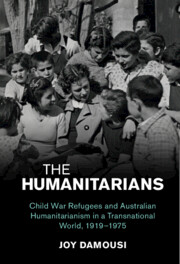 The Humanitarians
The Humanitarians The Case of Rosemary Taylor, Elaine Moir and Margaret Moses
from Part III - Assimilating and Adopting
Published online by Cambridge University Press: 28 July 2022
Chapter 11 looks at Rosemary Taylor and Ellen Moir, the leading Australian humanitarians during the Vietnam War. Both were staunch advocates of inter-country adoption and supported evacuating war orphans to Australia, the United States and other countries. This created great debate and controversy at the time. Rosemary Taylor was one of the most prominent and high-profile humanitarians over the course of the history of child refugees and humanitarianism. She arrived in Saigon in 1967 as an educational social worker with a refugee service sponsored by the Australian Council of Churches. Taylor’s efforts in Vietnam with child refugees and orphanages captured the attention of the press, which called the children ‘Rosemary’s babies’. Acting as an informal liaison officer for orphanages across Vietnam, she was involved with the infamous Babylift of 1975, in which several hundred children were flown out of Vietnam to Australia – some for adoption by Australian families. Ellen Moir, a staunch advocate for inter-country adoption, was involved in smuggling five orphans into Australia without permits or documents in 1972, and worked with Taylor to attempt to expand the possibility of Australians adopting Vietnamese War orphans. Moir lobbied government agencies to allow children to enter the country. The role of humanitarian activists such as Taylor and Moir working largely outside of organised bodies led to a form of humanitarian activism which was at times ad hoc, chaotic and strident, and which allowed them to advocate for inter-country adoption to be seen as a solution to the increase in the number of child refugees and war orphans.
To save this book to your Kindle, first ensure [email protected] is added to your Approved Personal Document E-mail List under your Personal Document Settings on the Manage Your Content and Devices page of your Amazon account. Then enter the ‘name’ part of your Kindle email address below. Find out more about saving to your Kindle.
Note you can select to save to either the @free.kindle.com or @kindle.com variations. ‘@free.kindle.com’ emails are free but can only be saved to your device when it is connected to wi-fi. ‘@kindle.com’ emails can be delivered even when you are not connected to wi-fi, but note that service fees apply.
Find out more about the Kindle Personal Document Service.
To save content items to your account, please confirm that you agree to abide by our usage policies. If this is the first time you use this feature, you will be asked to authorise Cambridge Core to connect with your account. Find out more about saving content to Dropbox.
To save content items to your account, please confirm that you agree to abide by our usage policies. If this is the first time you use this feature, you will be asked to authorise Cambridge Core to connect with your account. Find out more about saving content to Google Drive.